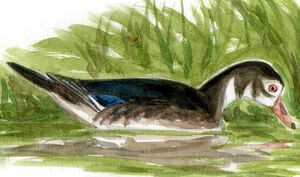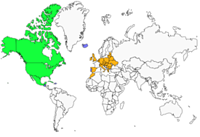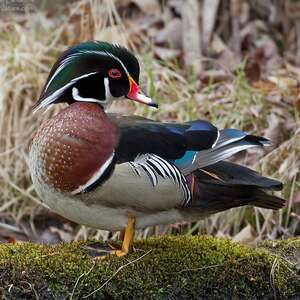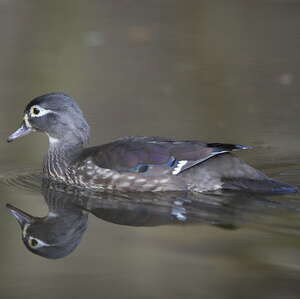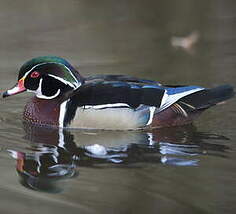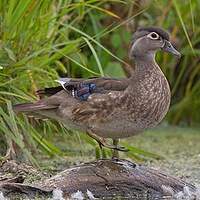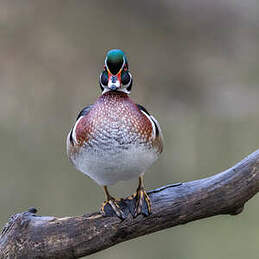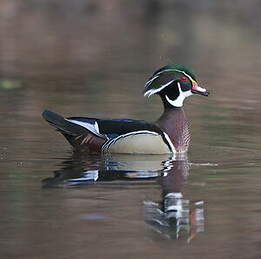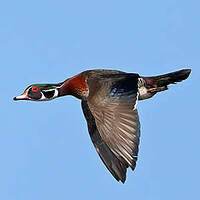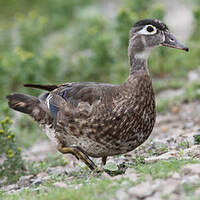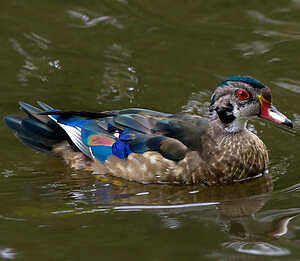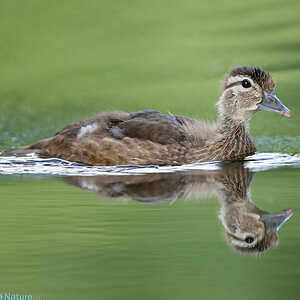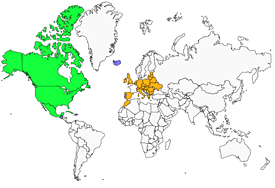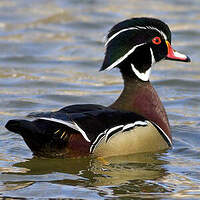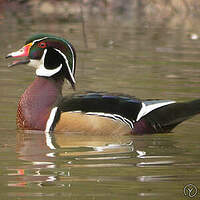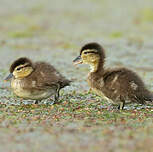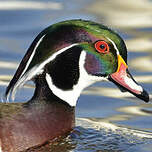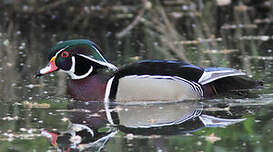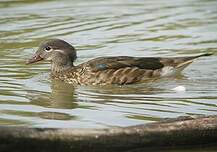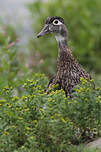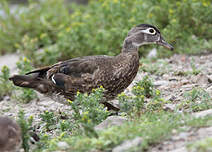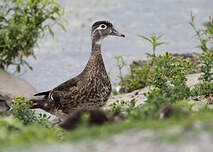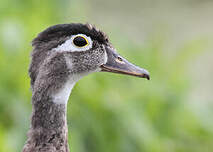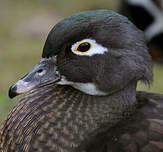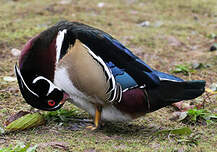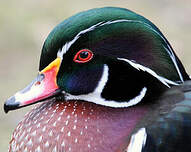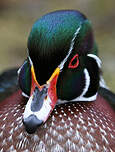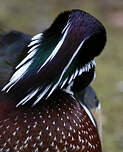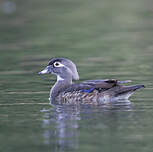Wood Duck
Aix sponsa - Canard carolin Canard branchu
Identification
The Wood Duck is one of the most colorful ducks in North America and without a doubt the most beautiful of waterfowl. Its scientific name Aix sponsa already translates the beauty of its plumage as a waterfowl in a wedding dress. Sexual dimorphism during the mating season is very strong. At this time, the male's head is adorned with a multitude of electric reflections, deep blue and dark green on the top going towards purple on the nape. This same purple color is also found on the eye stripes and cheeks. The area of the ear coverts is rather black. These iridescent colors emphasize the intense red of the eye as well as the orange-red orbital circle. The head is finely marked with rounded white lines. A first part of the lores passes above the eyes and extends to the nape. A second, shorter one, starts from the back of the eyes and follows the first one in parallel until it also ends on the nape. From the chin and throat, both white, start two short, rounded white bands. One starts from the mandibles and comes up to the eyes encompassing the cheeks, the other, under the cheeks and goes up to the nape. The beak is red sideways, pink on top with a black line on the culmen, the nail is black and the base of the mandibles is yellow. The neck is marked with a large black line. The chest is a brownish-purple dotted with small white marks on the center. The flanks are ocher pale to gray. Vertical black and white bars separate the flanks from the sides of the chest. The belly and lower belly are white. The femoral area is purple. The back, shoulder blades, rump, upper coverts, lower coverts, and tail are black. The great and medium coverts are dark with blue reflections with black tips. The great primary coverts are gray-brown. The secondaries, i.e. the mirror, have blue reflections.The trailing edge is white. The legs and feet are blackish-yellow. The eclipse male resembles the female but has a different bill colour.
The female is duller, overall a weakly speckled grey-brown. The head is grey with a white throat. A white spot forming a drop pointed backwards surround the eye. A white line surrounds the base of the bill that stands out against the yellow mandibles. The bill is dark grey, the nail and culmen are blackish. The tomium is pale pink. The brown eye has a yellow orbital ring. The chest and flanks are brown speckled with yellow fawn. The belly and lower belly are white. The rest of the body is brown with golden reflections. The wings are partially the same as the male's but with wider trailing edges. The legs are brownish-yellow like the male's. In both sexes the head is crowned with a crest that falls onto the neck and the tail is rectangular.
The juvenile resembles the female but even duller. The head's pattern is less defined and the cap is light brown. The eye is pale brown surrounded by an indistinct pale white orbital ring. The bill is brown, the tomium like the female's.
The chick is dark brown on the top and pale yellow underneath. It has small white spots on the wings, the bill is blue, the legs are black.
The Wood Duck cannot be confused with another species, however the female and juvenile resemble those of the Mandarin Duck which can be found in the wild in the Wood Duck's range.
Subspecific information monotypic species
Foreign names
- Canard carolin,
- Pato joyuyo,
- pato-carolino,
- Brautente,
- kisasszonyréce,
- Carolina-eend,
- Anatra sposa,
- brudand,
- Brudeand,
- kačička obojková,
- kachnička karolínská,
- Brudeand,
- morsiosorsa,
- ànec de Carolina,
- Brúðönd,
- karolinka,
- koku pīle,
- nevestica,
- Каролинская утка,
- アメリカオシ,
- 林鸳鸯,
- 林鴛鴦,
Voice song and cries
The male emits prolonged, increasingly high-pitched whistles: duuiiiz and di-di-djizz. Outside of the breeding season, the Wood Duck is relatively quiet. The female, on the other hand, emits different audible cries: anh i-yik. She cries when fleeing or when disturbed.
Habitat
Behaviour character trait
The Wood Duck swims, walks and flies. It is a surface duck that prefers more enclosed environments than other ducks.
It looks for places where water and branches mix and stays perched on top of the branches for long periods. Unusual for water birds, it has wide claws that allow it to cling to tree bark. It usually feeds in shallow water, pecking at the surface most often. It is not a diving duck, though diving is not to be excluded. In case of lack of aquatic food, it may go searching for food on the forest floor. In small groups, individuals may still converge in the fall and winter to form groups as large as 1,000 individuals. Monogamous in the same season, it is not territorial, though it may defend its mate if a congener gets too close. The reproduction period depends on the region of dispersal. Populations from the south reproduce from January-February, while populations from the north reproduce from March-April. The species nests in trees, occupying old spots of the Great Spangled Woodpecker (Dryocopus pileatus) or other natural cavities while adapting perfectly to artificial nests. In the wild, hybridization is rare, sometimes reported with the Mallard and more frequently with the Ring-necked Duck, the Common Goldeneye, the Crowned Crested Grebe, not excluding the Red-headed Duck. In captive environments, hybridizations occur more often because the Wood Duck has the reputation of being enterprising with any species presented.Flight
Dietfeeding habits
Reproduction nesting
During the mating display, the male swims in front of the female with wings and tail raised, frantically moving its iridescent feathers. The female, meanwhile, whistles to attract the males. Mutual feather smoothing is also frequent. The female is in charge of choosing the nesting site, accompanied by the male. The nest is placed in a tree cavity and covered by the female's breast feathers. She lays between 6 and 16 white-cream to ochre eggs that she incubates for 23 to 37 days. The location and proximity of the cavities cause the females to lay eggs in the nests of other females.
This reduces competition due to nesting site and considerably increases the number of young for a nest. This behavior is known as nest dumping. A clutch can have more than thirty chicks. Nevertheless, competition with other species exists. This is the case with squirrels, bees, introduced Starlings, Hooded Crows, and Crowned Crows, which also lay eggs in the nests of female Wood Ducks. Compared to other Anatidae, the male does not leave the female just after the birth of the chicks. He remains nearby and can thus produce a replacement clutch in case of high mortality, or even make a second clutch in the south of its area. Two days after birth, the female leaves the nest and calls her young from the outside. The latter already have claws and climb the inside of the nest before jumping off the edge. No matter the height, it is rare that the young chicks get injured during their first big jump. In case of visible danger, the female emits a whistle which causes the immediate diving of the young. They become independent and flying between 8 and 10 weeks. However, various threats weigh on them.Many predators such as mink, snakes, raccoons and eastern snapping turtles are responsible for more than 85% of mortality in ducklings less than two weeks old. Nesting females are exposed to foxes and raccoons.Geographic range
The Wood Duck is exclusively a Neartic breeder, rarely wintering as far south as Mexico. Two populations are found across North America. The east coast population breeds from southern Canada to Florida, and the west coast population breeds from British Columbia to California. Occasional visitors to the Azores and western Europe are also recorded. A relatively frequent captive species, easy to breed and relatively inexpensive, escapees are thus common in western Europe, although they struggle to establish feral populations. Between 50 and 100 pairs have been recorded in Europe, mainly in Germany and Belgium.
Threats - protection
IUCN conservation status
concern
in the Wild
threatened
evaluated
The population of Wood Duck has drastically decreased during the 20th century, largely due to excessive hunting for its flesh but also for the beauty of its feathers. After significant protection measures such as the introduction of the Convention on the Protection of Migratory Birds in Canada and the USA (the Migratory Bird Treaty Act of 1918 in the USA and the Migratory Bird Convention Act of 1917 in Canada) which put an end to unregulated hunting, the species has bounced back. Unfortunately, the Wood Duck is still facing other threats such as the loss and degradation of its habitat due to marsh drainage and other human activities that destroy its wooded areas. Many nesting boxes are installed and measures to preserve and restore habitat are strongly recommended.
Sources of information
- IOC World Bird List (v14.1), Gill, F and D Donsker (Eds). 2023.
- Canards, cygnes et oies d'Europe, d'Asie et d'Amérique du Nord, Reeber Sébastien
- ARKive, Christopher Parsons
- BirdLife International, BirdLife International
Other sources of interest
 Specification sheet created on
24/07/2023 by Nathalie Santa Maria
Specification sheet created on
24/07/2023 by Nathalie Santa MariaTranslation by AI Oiseaux.net
published: 25-09-2016 - Updated: 26-09-2016
© 1996-2024 Oiseaux.net
- Accipitriformes
- Aegotheliformes
- Anseriformes
- Apodiformes
- Apterygiformes
- Bucerotiformes
- Caprimulgiformes
- Cariamiformes
- Casuariiformes
- Charadriiformes
- Ciconiiformes
- Coliiformes
- Columbiformes
- Coraciiformes
- Cuculiformes
- Eurypygiformes
- Falconiformes
- Galliformes
- Gaviiformes
- Gruiformes
- Leptosomiformes
- Mesitornithiformes
- Musophagiformes
- Nyctibiiformes
- Opisthocomiformes
- Otidiformes
- Passeriformes
- Pelecaniformes
- Phaethontiformes
- Phoenicopteriformes
- Piciformes
- Podargiformes
- Podicipediformes
- Procellariiformes
- Psittaciformes
- Pterocliformes
- Rheiformes
- Sphenisciformes
- Steatornithiformes
- Strigiformes
- Struthioniformes
- Suliformes
- Tinamiformes
- Trogoniformes

